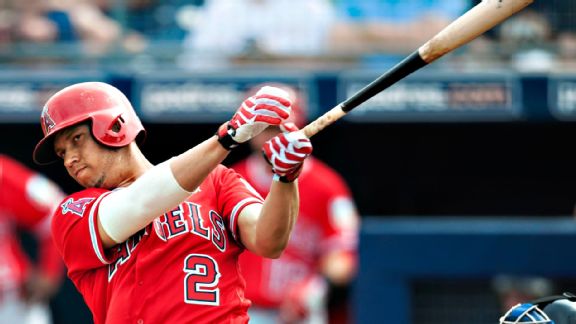Here’s your first warning and disclaimer that the 2017 MLB season is not even a month old so proceed with caution with these small sample sizes(SSS). With that out of the way, there’s one Angels player who is showing an encouraging trend early: Andrelton Simmons. Yes, his defense has been superb so far as it’s always been but that’s not the only area where Simmons is excelling. He’s doing some excellent work at the plate that might not just be random noise.
Through 63 plate appearances, Andrelton Simmons has a .286/.365/.411 line, which is good for a healthy 131 wRC+ that is well above his career 86 wRC+. On Tuesday night in Houston, Simmons hit a 361 foot home run on a ball scalded at a 97 mph exit velocity. This home run in particular was special because it represented the 1st opposite field home run of his career, occurring after 36 home runs to start his career that were hit to left field or center but nothing the other way. His .411 slugging percentage and .125 ISO he’s putting up this season aren’t elite power numbers but they represent huge improvements over his career marks(.364 SLG and .103 ISO). To get a clearer idea if this production is real or not, it’s always smart to look at a players’ batted ball profile, viewing his ground ball rates and fly ball rates. Through 16 games, Simmons is posting career high marks in line drive rate(22.9%), opposite field hit rate(33.3%) and hard hit rate(33.3%). He’s posting a career low soft hit rate(16.7%) and his ground ball rate(50%) is the 2nd lowest figure of his career. Another big development for Simmons: He’s making harder contact by whopping standards. Last season, the Angels shortstop had a 86.4 mph average exit velocity, which was below league average. So far in 2017, Simmons is at 89.76, more than 3 mph better than 2016. As a result, Simmons is posting a .304 BABIP, well above his .275 career mark, and in this case, you can’t just discount it and assume that will regress. Again, we are talking about a grand total of 16 games but when you’re making harder contact, hitting more line drives and using the whole field more, it’s hard to not take notice.
The improved batted ball numbers and the authority Simmons is hitting the baseball with isn’t the only noticeable trend. Simmons is walking way more than he ever has while also striking out more. For a player with this profile(career 6.2 BB% and 9.0 K%), the trade off to get on base more while striking out a bit more seems like an obvious positive move. Through 63 plate appearances, Simmons has walked 7 times while striking out 8 times, translating to a 11.1 BB% and 12.7 K%. Not only is that walk percentage a huge improvement but even the increase in strikeouts has Simmons well below the league average strikeout rate. With the 3 true outcomes(home runs, walks, strikeouts) becoming more popular at the plate, it looks like that epidemic has affected Simmons to start the season. More power and more walks are almost always a good thing, even with a few more strikeouts and it has created a well above average hitting Andrelton Simmons to start the year.
The numbers are always a good place to start when viewing a player’s changes in his offensive profile but video evidence is another route to go. First, a video of a home run in the 1st week of the 2017 season, followed by a home run hit last September.
A few things stand out immediately. In 2016, Simmons is hunched down a bit more, stands closer to home plate and his hands are lower and not in an optimal position to create a better bath path geared towards hitting the ball harder.
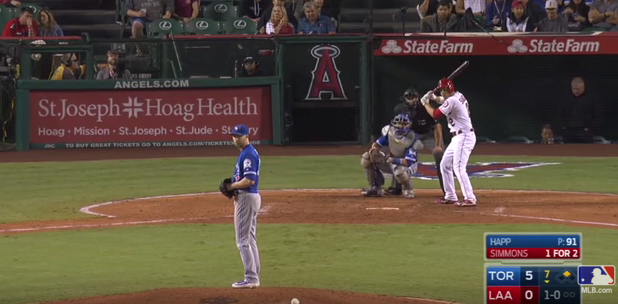
In 2017, Simmons is more upright(see, Mike Trout progression from 2011 to now), he’s a bit further from home plate and his hands are in a more optimal position for hard contact.
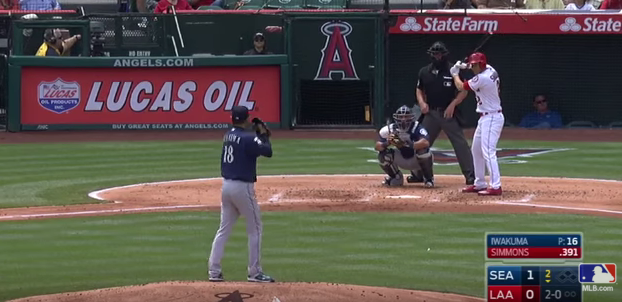
In many cases for players who improve in the power department, the first place they resort to is their hands. Simmons, based on the video, creates a steeper launch angle with his hands, dropping them during the transition from the load to the point of contact, which creates more upward plane to hitting the baseball. Compare that to 2016 when Simmons hands basically go from Point A(loading hands) to Point B(making contact). The 2016 swing matches up with the numbers, which looks more designed to just make contact with the baseball with a quick, choppy swing but saps some potential power.
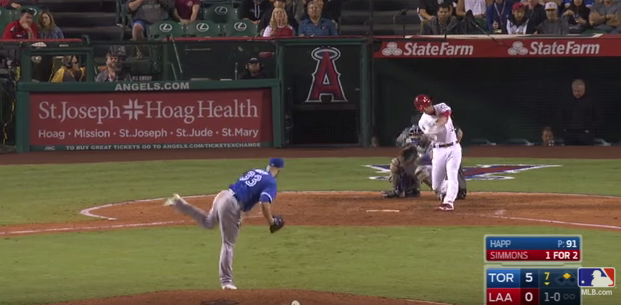
In 2017, Simmons is creating more angle with his bat path, which leads to more authoritative contact but can lead to some more swings and misses. The results so far are promising for Simmons, who seems to be tapping into his raw power a bit more this season.
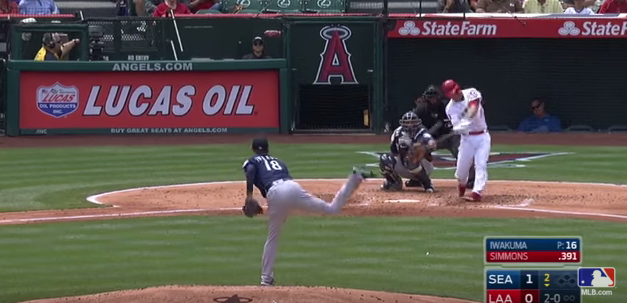
At age 27, Andrelton Simmons seems like he’s destined for a potential career year or may potentially set a higher bar at the plate. As discussed above, we are dealing with a short sample here but many of these statistics(specifically fly ball, ground ball, line drive and walk rates) tend to stabilize pretty quickly. Based on the swing changes we have seen so far, it’s possible that Simmons can be a league average bat, or potentially better, moving forward. With elite level defense, Simmons is a borderline superstar with that type of bat. With 4 years remaining on his deal, the Angels could be getting some serious production until 2020. It’s early but the first look at the 2017 Andrelton Simmons is an encouraging one.
Add The Sports Daily to your Google News Feed!
